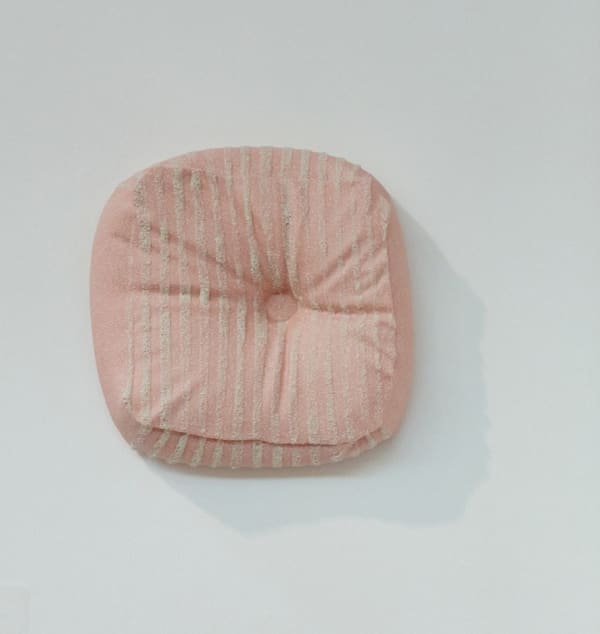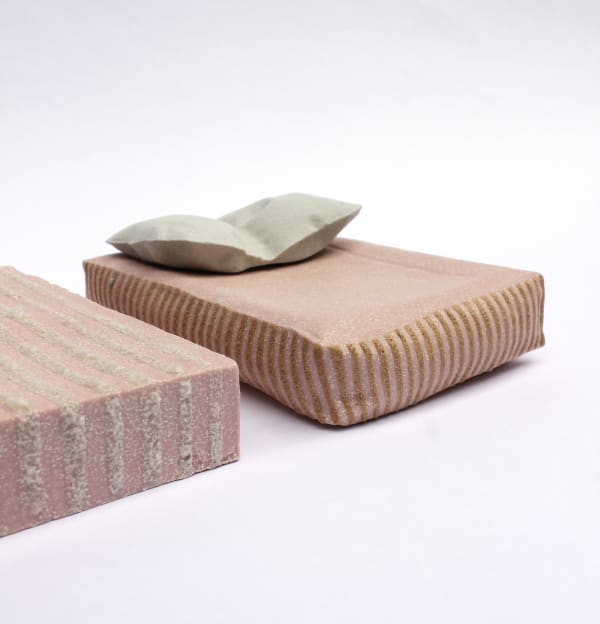-

-
 Three sculptures from Alice's Pillow Series (details below)
Three sculptures from Alice's Pillow Series (details below) -
In this feature, we share a recent interview with Marthe Lisson, editor of Think Pieces, the UCL Institute of Advanced Studies' online review. In the interview Alice talks about what motivates her practice, the beauty of 'wasted' objects, the versatility of the material clay, and she shares her thoughts about waste in the ceramics industry.
Ways of Waste - Intimate Objects a Conversation with Ceramicist Alice Foxen
Marthe Lisson
How did you find your way into ceramics?Alice Foxen
"I think I always knew that I was going to art school because both of my parents went to art school. On my foundation course, I was actually doing a lot of metal work and was finding it very difficult to manipulate it quickly and easily to sketch out ideas. So my tutor gave me some clay to model ideas out and I just found it to be a very immediate medium. That was my way into it. I didn’t really focus on ceramics until after my BA. I did my BA in Brighton and it was called 3D Design and Craft. It was a foundation course in materials, with wood, metal, ceramics, and plastic. I did major in ceramics, but it took that interim period between BA and MA of almost eight years to refine what I actually loved about clay. It is such a broad material, and you can do so much with it. You can be sculptural, you can be functional, you can make it look like something entirely different. You can focus on glaze, you can focus on clay, on form, on materiality."Now I’ve done a masters. I graduated from the Royal College in July 2022, I think all of that time from the age of 19 to the age of 33 now, has been a fascination with material and a curiosity for what it can do and how it can surprise me. I think that’s what I like about ceramics. You put something in, you make this mixture, you give it rules, you think you know what it’s going to do. You create a recipe and then you give it over to the force of the kiln and its heat, and it will change. And it will give you something that you didn’t know before. And that’s what I’m aiming for every time: to create something I didn’t know about."
ML
I love that, this aspect of letting yourself be surprised. And it does not only apply to the material you work with. It is also the source of inspiration.AF
"Yes, that’s what I love about being inspired by discarded objects, I don’t know about them. I don’t know when they are going to appear to me, and they are taken out of context and it’s always a surprise. They can be humorous; they have a character sometimes. Like “oops, this appeared on this corner, with some other unexpected object and they have just been left there!” Because they’re ‘waste,’ and because they are just disregarded, no one is looking at them in my mind apart from me. Nobody is taking a picture of the thing on the floor, everyone is taking pictures of the shiny thing in the sky. It’s finding something I don’t know about. It’s finding that uniqueness and recording it. It is something I find worth doing."ML
How do you transfer these objects into your work. You are not just making small scale replications
of them.AF
"I don’t tend to work from images even though I take a lot of photographs and collate them into groups… and I will look at them, but I won’t work from them directly. It is more about this sense or the feeling I got from that encounter and the different things that I’ve been looking at. They are all grouped together and, in my head, become one universal object. The thing I make is never directly linked to one thing. It’s sort of abstracted and maybe a little uncanny, but I also like to echo the stillness of the moment. My colour palette is coming from my own imagination. It is faded, a little bit nostalgic sometimes. Texturally trying to mimic some of the qualities of fabric, plastic or road surface." -
ML
Texture seems to be very important to you. Sometimes you post pictures on Instagram of the objects you found in the street and then one image of the object you have created from that encounter. Very often, it is the texture that links them.AF
"I’ve done work that has a shimmer to it, the lightness of the foam or sometimes the way things are slumped. Maybe I moved away from this now. But I was definitely thinking before about the movement of my pieces. Even if it’s a little awkward for me to stand there and take pictures of rubbish – people sometimes think I’m from the Council – I have to take a picture because otherwise it’s going to go, or I won’t get the quality I want from it.
"I realised on the way here that I almost exclusively now take pictures of soft things. Maybe because I’ve been more interested in making pillows out this latex fabric." -
 Sofa Pillow (pink), 2023 nestled in between textile work by Dalia James and Isabel Fletcher at our recent 20th anniversary show
Sofa Pillow (pink), 2023 nestled in between textile work by Dalia James and Isabel Fletcher at our recent 20th anniversary show -
ML
Your little pillows look so soft that you want to squeeze them. This element of turning a solid material into something that looks soft and fluffy, I really like about your work. Also, the combination of soft materials, like the latex, and solid materials. Sometimes when I see pictures of your objects on Instagram, I can’t tell whether the latex might just be a super thin sheet of ceramic. You said it at the beginning of our conversation, you can use the material clay and turn it into something that doesn’t look like clay anymore. I find that fascinating.AF
[Looking at her objects on the work bench]
"It’s funny to look at how things go in cycles. I’ve always been on the same sort of thread. One thing goes to another to another…"ML
There is a nice continuity in your work. It always evolves around the same subject, but you’re looking at it from different angles.AF
"Sometimes I think I work too tightly. Maybe I’ve come to that point again where there is no sign of my own hand in my work. I try really hard to eradicate any sign of my own making. It’s like “It’s just there, it just appeared.” I feel like I need to expand, things have gotten too enclosed and I need to break out again. But that will be in the new year."ML
What is it exactly that fascinates you about discarded objects? You have alluded to it, but is it that only you see them? Or that you have only this very moment to capture it because the next moment the actual Council might take it away? Or is it the surprise?AF
"Sometimes they can be very beautiful. A slumped mattress might have a really nice line quality to it. And they are very intimate objects. I don’t know whether I’m so interested in the social aspect of peering into people’s lives and what different people leave out. It’s funny what people don’t care for anymore, it’s public! As soon as people lose the attachment to it, they don’t care that everyone can see it."ML
Interesting that you mention the intimacy of some of those objects because you turn them into quite intimate objects again. Your objects are rather small and delicate.AF
"I want to keep a sense of empathy towards the thing that I find. To not necessarily make it beautiful again, but to give it a new appreciation."ML
And to give it the attention that it didn’t get at the corner of the street, or at its former home?AF
"To give it time."ML
And permanence. The original object is being discarded. Who knows where it goes? You give it a permanent afterlife.AF
"I like to use repetitive processes that are often quite time consuming for no other reason than the process being meditative. And that echoes my approach to research, to find material to work from. It’s like stopping. Mindfully looking. And then mindfully making."Continue reading the full IAS interview by Think Pieces Editor Marthe Lisson with Alice here
-
See more of Alice's available work







